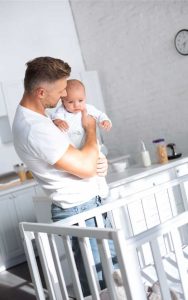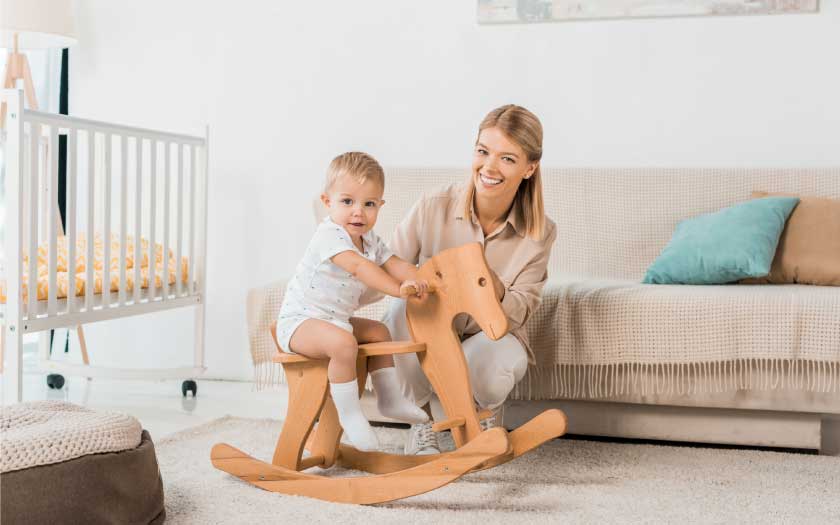Having a baby or toddler at home means having to pay more attention to the safety around you. We all know by now that babies and toddlers fear very little, and don’t know any better when it comes to their safety.
This is why we hear about accidents taking place in the home when the home is where you least expect things to go wrong. Read on…
As parents, you’ll have to take steps to ensure that your home (every inch of it!), is safe for your inquisitive little one to live in. We hope this special guide will help you with ideas on home safety and what you need. Firstly, even if you just had a baby, know this: Your newborn infant will not remain immobile for long. As soon as your baby begins to crawl, he’ll be curious to move about as much as he can. This is why babyproofing your home is something you’d want to think about (and get done) even before the baby arrives.
Be alert during bath times
Prior preparation is needed before your little one’s bath time so you’ll never have to step away from a baby at any time throughout the little one’s bath time. Items such as towels, washcloths, soaps, and shampoos have to be at arm’s reach and easy to access without having to let go of your baby.
It would be good to remember to ignore any distractions that come your way at this time, such as the phone ringing or even the doorbell, till your baby is safely out of the tub (and said tub is emptied if there are other small children in the house).
Baby bath support products such as mats, seats, and such should never take the place of a parent’s firm hold at any time during bath times. They are only meant to support the weight of the baby and take some burden off the parent’s hand and arm. It is crucial that babies and even toddlers, who happen to be naturally top-heavy, are never left unattended in the bathtub, or bathroom for that matter.
Warning:
Accidental drowning is known to occur quickly and silently, even in an inch of water.
Locks, guards, and covers
You’ll need to look into protecting baby from dangers from electrical outlets as well as edges and corners. It’s important to keep in mind your little one’s perspective of your home as he goes around discovering his surroundings.
It will help to get down on all fours to have an idea of what your little one sees at his eye-level, and electrical outlets are probably one of the first things you will notice. Carefully look around each room, find all of the outlets, and seal vacant outlets. Cover the rest with outlet covers whenever not in use.
Keep bumps and bruises at bay with cushioned corner guards and edging for all those protruding edges and corners. These corner guards can attach to end tables, corners of the hallway, and more.
Crib safety
Most modern cribs are designed according to international safety standards, but how you use the crib is entirely in your hands. Experts advise against crowding a baby crib with pillows, blankets, and stuffed toys, for these may easily smother a baby and cause suffocation. Notice how a baby’s hands tend to grip anything and everything? That means items with strings or cords attached to them are also a no-no, for they pose serious choking and strangulation risks. If your baby’s crib is placed beside a wall, avoid hanging anything on that wall, such as framed pictures, wall decorations, etc. This is to avoid incidents of wall decor falling and injuring the baby in the crib.
Window safety
This is a crucial part of baby proofing a home, especially if you live in a condominium or apartment. Fix window locks and window guards to prevent fatal falls or other nasty accidents. Do you have blinds with cords or strings? Replace them with safer window coverings, such as cordless options. When it comes to baby-proofing your home, you’ll find that you’ll never run out of uses for safety gadgets, so check out all baby proofing sets and kits for sale by reputable brands and start making your home a haven for your little one.
Dangers of drawers and windows
Babies and toddlers are fascinated with things that can be opened and closed, such as cabinets, drawers, and doors. Install safety latches on all drawers and cabinets, and finger pinch guards on all door hinge to protect your baby’s tiny hands from painful injuries. Look for a secure lock to place in the bathroom to avoid accidental drowning.
Under-sink cabinets are a typical place to store cleaning products, but with baby in residence, you need to move them out of reach. If they must stay in low cabinets, invest in latches and locks to always keep the cabinet doors securely shut. If you don’t have an out-of-reach place to store medicines and supplements, invest in a lockable medicine safely.
Things that close and open
Babies and toddlers always seem to be attracted to cabinets, drawers, and doors – they’re always trying to open them or close them. This interest, however, is capable of causing injury to their fingers when they’re pinched or slammed on. Install finger pinch guards on all door hinges to protect your baby’s tiny hands and remove rubber caps from mounted door stoppers, as they are a choking hazard.
Limit accessibility
Don’t forget to remove all step stools and ladders from the kitchen as well to limit accessibility to out-of-reach items.
Child-proof safety gates
Here’s an item that’s directly related to baby proofing – one that we cannot escape from if we’re talking about the subject. Most homes will need more than one of these gates, to stop little ones from entering certain rooms in the house. Areas that typically need these child safety gates include the kitchen (if it does not have a door), at the bottom and top of staircases, home offices, etc. A child-proof safety gate can also be placed at a spot where you’d like to keep the door open, yet do not want your baby or toddler wandering into it.
You’ll find these gates in a variety of styles, height, and mechanism options. So, before you go looking for one (or more), be certain of:
- Where you need to set them up
- The kind of closing/opening mechanism you’d prefer
- The width of the gate
- The best gate height for your needs
Most of these safety gates are made from durable plastic, but you can also find some made from wood or even metal. These days, you can probably find a gate to fit even the most awkward nook or even to cordon off a wider than usual space.
Child safety gates are installed either by pressure with hardware. Pressure mounted gates fit between two walls and held in place by pressure or tension. To be safe, avoid installing this type of gate at the top of a staircase, as a child’s body weight could easily dislodge the gate, resulting in potentially dangerous accidents. Hardware mounted safety gates are sturdier, but they may require more work to install.
Always remember, while baby gates substantially reduce the risk of injury, accidents can still happen if the baby is in a push-pull toy near the stairs, carried by a distracted or encumbered adult, or the stairs are cluttered. It’s best to be smart, take the proper precautions, and always monitor your child near stairways.
Peace of mind with baby monitors
Parents of babies constantly wish that they have eyes that see what’s happening in their baby’s room while they go around their daily routines in other areas of the home. Well, thanks to baby monitors, now they can!
While a parent’s presence and watchful eyes are the best protection for a baby, modern baby monitors can still offer an extra set of eyes and ears to check on baby anytime. With so many options, it’s most important you purchase one that fits your needs and makes you confident the baby is safe and sound.

It’s probably best to choose a model that has multiple units and can be powered by both battery and an A/C adapter. This will help ensure that you’ll always be able to check on your baby. You could also consider purchasing a monitor that comes with a waistband clip to free your hands, as well as audio and video models that can display split screens for when you have more than one monitor running – these will be ideal for families with a few little ones to keep an eye on.
In terms of babyproofing your home, think:
- Safety gates for stairs and entrances you want to keep baby away from
- Safety cover for power sockets
- Furniture edge and corner guards
- Window railings and window guards
- Safety door stoppers and doorknob covers
- Securing heavy furniture to the wall or ground to prevent them from falling or toppling over
While the above are the basic needs for baby proofing your home, you’ll think of more necessities and also more ways to keep your little one safe as needs change. As with everything else to do with baby care, constant supervision and attentiveness is the actual real key in keeping little ones safe from harm. Everything else is to support that effort.


